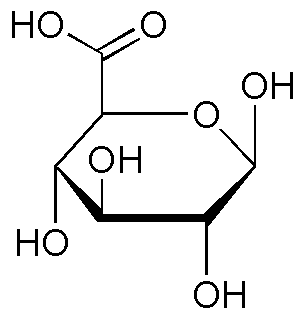D-Glucuronic acid is widely utilized in research focused on:
- Pharmaceutical Development: It plays a crucial role in drug formulation, enhancing the solubility and bioavailability of various medications, making them more effective for patients.
- Detoxification Processes: This compound is essential in the liver for detoxifying drugs and toxins, aiding in their excretion and reducing potential side effects in therapeutic applications.
- Cosmetic Industry: D-Glucuronic acid is used in skincare products for its moisturizing properties, helping to improve skin hydration and elasticity, which is beneficial for anti-aging formulations.
- Food Industry: It serves as a food additive, acting as a stabilizer and thickening agent in various products, enhancing texture and shelf life.
- Biotechnology: Researchers utilize it in the synthesis of glycosaminoglycans, which are important in tissue engineering and regenerative medicine, offering innovative solutions for healing and repair.
General Information
Properties
Safety and Regulations
Applications
D-Glucuronic acid is widely utilized in research focused on:
- Pharmaceutical Development: It plays a crucial role in drug formulation, enhancing the solubility and bioavailability of various medications, making them more effective for patients.
- Detoxification Processes: This compound is essential in the liver for detoxifying drugs and toxins, aiding in their excretion and reducing potential side effects in therapeutic applications.
- Cosmetic Industry: D-Glucuronic acid is used in skincare products for its moisturizing properties, helping to improve skin hydration and elasticity, which is beneficial for anti-aging formulations.
- Food Industry: It serves as a food additive, acting as a stabilizer and thickening agent in various products, enhancing texture and shelf life.
- Biotechnology: Researchers utilize it in the synthesis of glycosaminoglycans, which are important in tissue engineering and regenerative medicine, offering innovative solutions for healing and repair.
Documents
Safety Data Sheets (SDS)
The SDS provides comprehensive safety information on handling, storage, and disposal of the product.
Product Specification (PS)
The PS provides a comprehensive breakdown of the product’s properties, including chemical composition, physical state, purity, and storage requirements. It also details acceptable quality ranges and the product's intended applications.
Certificates of Analysis (COA)
Search for Certificates of Analysis (COA) by entering the products Lot Number. Lot and Batch Numbers can be found on a product’s label following the words ‘Lot’ or ‘Batch’.
*Catalog Number
*Lot Number
Certificates Of Origin (COO)
This COO confirms the country where the product was manufactured, and also details the materials and components used in it and whether it is derived from natural, synthetic, or other specific sources. This certificate may be required for customs, trade, and regulatory compliance.
*Catalog Number
*Lot Number
Safety Data Sheets (SDS)
The SDS provides comprehensive safety information on handling, storage, and disposal of the product.
DownloadProduct Specification (PS)
The PS provides a comprehensive breakdown of the product’s properties, including chemical composition, physical state, purity, and storage requirements. It also details acceptable quality ranges and the product's intended applications.
DownloadCertificates of Analysis (COA)
Search for Certificates of Analysis (COA) by entering the products Lot Number. Lot and Batch Numbers can be found on a product’s label following the words ‘Lot’ or ‘Batch’.
*Catalog Number
*Lot Number
Certificates Of Origin (COO)
This COO confirms the country where the product was manufactured, and also details the materials and components used in it and whether it is derived from natural, synthetic, or other specific sources. This certificate may be required for customs, trade, and regulatory compliance.


